Copper of fixed volume V is drawn into wire of length l. When this wire is subjected to a constant force F, the extension produced in the wire is Δl. Which of the following graphs is a straight line?
| 1. | Δl versues 1/l | 2. | Δl versus l2 |
| 3. | Δl versus 1/l2 | 4. | Δl versus l |
नियत आयतन V के कॉपर को लंबाई l के तार में खींचा जाता है। जब इस तार पर एक नियत बल F लगाया जाता है, तो तार में उत्पन्न प्रसार Δl है। निम्नलिखित में से कौन सा ग्राफ एक सरल रेखा है?
| 1. | Δl बनाम 1/l | 2. | Δl बनाम l2 |
| 3. | Δl बनाम 1/l2 | 4. | Δl बनाम l |
The ratio of Young's modulus of wire A to wire B
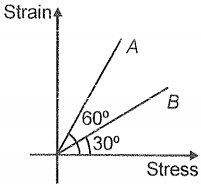
1. 3:1
2. 1:3
3. :1
4. 1:
तार A का तार B के यंग मापांक के साथ अनुपात है:
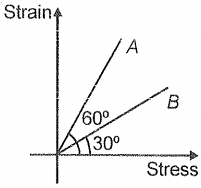
1. 3:1
2. 1:3
3. :1
4. 1:
If stress versus strain plot for a metal at two different temperatures
\(T_1\) and \(T_2\) are shown below, then:
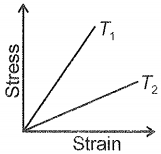
1. \(T_{1} > T_{2}\)
2. \(T_{1} < T_{2}\)
3. \(T_{1} = T_{2}\)
4. \(T_{1} = \frac{1}{T_{2}}\)
यदि दो भिन्न तापों \(T_1\) और \(T_2\) पर एक धातु के लिए प्रतिबल बनाम विकृति के ग्राफ निम्नवत दर्शाए गए हैं, तब:
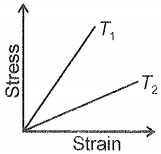
1. \(T_{1} > T_{2}\)
2. \(T_{1} < T_{2}\)
3. \(T_{1} = T_{2}\)
4. \(T_{1} = \frac{1}{T_{2}}\)
Three wires A,B,C made of the same material and radius have different lengths. The graphs in the figure show the elongation-load variation. The longest wire is
1. A
2. B
3. C
4. All
समान पदार्थ और समान त्रिज्या के तीन तारों A, B, C की लम्बाईयाँ अलग-अलग हैं। आकृति में ग्राफ, विस्तार-भार परिवर्तन दर्शाते हैं। सबसे लंबा तार है:
1. A
2. B
3. C
4. ये सभी
The elongation (x) of a steel wire varies with the elongating force (F) according to the graph: (within elastic limit)
| 1. | 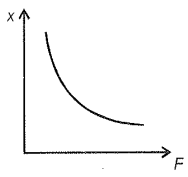 |
2. | 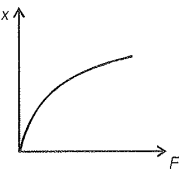 |
| 3. | 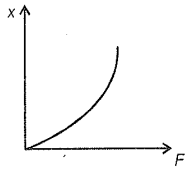 |
4. | 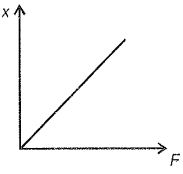 |
स्टील के तार का विस्तार (x), प्रत्यारोपित बल (F) के साथ (प्रत्यास्थता सीमा के भीतर) किस ग्राफ के अनुसार परिवर्तित होता है?
| 1. |  |
2. |  |
| 3. |  |
4. |  |
The stress-strain curve for two materials A and B are shown in the figure. Select correct statement-
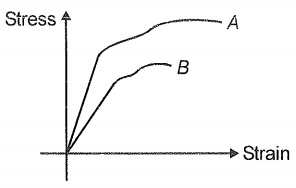
| 1. | Material A is less brittle and less elastic as compared to B |
| 2. | Material A is more ductile and less elastic as compared to B |
| 3. | Material A is less brittle and more elastic than B |
| 4. | Material B is more brittle and more elastic than A |
दो पदार्थ A और B के लिए प्रतिबल-विकृति वक्र को आकृति में दर्शाया गया है। सही कथन का चयन कीजिए
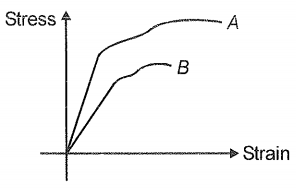
| 1. | पदार्थ A, B की तुलना में कम भंगुर और कम प्रत्यास्थ है |
| 2. | पदार्थ A, B की तुलना में अधिक तन्य है और कम प्रत्यास्थ है |
| 3. | पदार्थ A, B की तुलना में कम भंगुर और अधिक प्रत्यास्थ है |
| 4. | पदार्थ B, A की तुलना में अधिक भंगुर और अधिक प्रत्यास्थ है |
Two wires X and Y of the same length are made of the same material. The figure represents the load F versus extension graph for the two wires. Hence
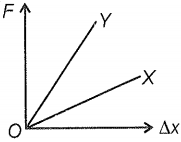
| 1. | Modulus of elasticity of Y is greater than that of X |
| 2. | Stiffness of Y is more than that of X |
| 3. | The cross-sectional area of Y is less than that of X |
| 4. | All of these |
समान लंबाई के दो तार X और Y सामान पदार्थ से बने हैं। आकृति दोनों तारों के लिए भार F बनाम प्रसार के ग्राफ का निरूपण करता है। इसलिए:
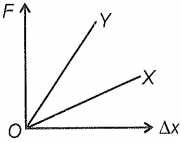
| 1. | Y का प्रत्यास्थता मापांक X की तुलना में अधिक है |
| 2. | Y की दृढ़ता X की तुलना में अधिक है |
| 3. | Y के अनुप्रस्थ काट का क्षेत्रफल, X के अनुप्रस्थ काट के क्षेत्रफल से कम है |
| 4. | ये सभी |
The diagram shows a force-extension graph for a rubber band. Consider the following statements
I. It will be easier to compress this rubber than expand it
II. Rubber does not return to its original length after it is stretched
III. The rubber band will get heated if it is stretched and released
Which of these can be deduced from the graph?
1. III only
2. II and III
3. I and III
4. I only
आरेख रबर बैंड के लिए बल-विस्तार ग्राफ दर्शाता है। निम्नलिखित कथनों पर विचार कीजिए:
I. इस रबर को विस्तारित करने की तुलना में इसे संपीडित करना आसान होगा
II. रबर खिंचने के बाद अपनी मूल लंबाई में वापस नहीं आती है
III. यदि इसे खींचकर छोड़ दिया जाए तो रबर बैंड गर्म हो जाएगा
इनमें से कौन सा परिणाम ग्राफ से प्राप्त किया जा सकता है?
| 1. | केवल III | 2. | II और III |
| 3. | I और III | 4. | केवल I |
To break a wire, a force of is required. If the density of the material is , then the length of the wire which will break by its own weight will be -
| 1. | 34 m | 2. | 30 m |
| 3. | 300 m | 4. | 3 m |
एक तार को तोड़ने के लिए, बल की आवश्यकता होती है। यदि पदार्थ का घनत्व है, तो तार की वह लंबाई, जो अपने स्वयं के वजन से टूट जाएगी, होगी -
| 1. | 34 m | 2. | 30 m |
| 3. | 300 m | 4. | 3 m |
The Young's modulus of a wire of length 'L' and radius 'r' is 'Y'. If length is reduced to L/2 and radius r/2, then Young's modulus will be
1. Y/2
2. Y
3. 2Y
4. 4Y
लंबाई 'L' और त्रिज्या 'r' के तार का यंग मापांक 'Y' है। यदि लंबाई L/2 और त्रिज्या r/2 तक कम हो जाती है, तो यंग मापांक होगा:
1. Y/2
2. Y
3. 2Y
4. 4Y








